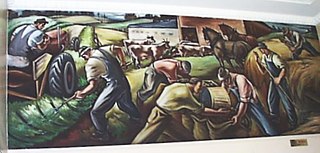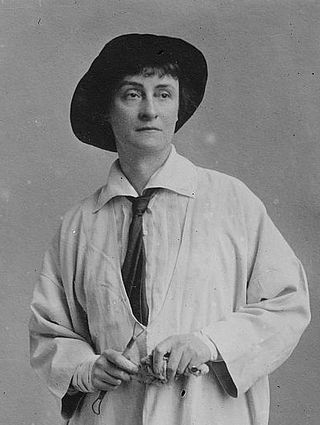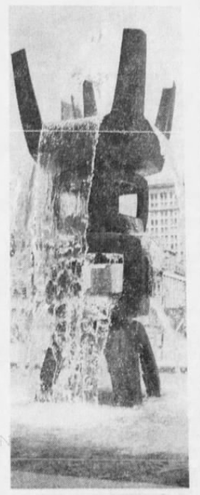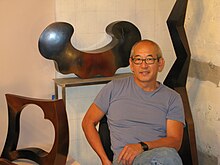
The Northwest School was an American art movement established in the Seattle area. It flourished in the 1930s–40s.

The Sphere is a monumental cast bronze sculpture by German artist Fritz Koenig (1924–2017).

Janet Scudder, born Netta Deweze Frazee Scudder, was an American sculptor and painter from Terre Haute, Indiana, who is best known for her memorial sculptures, bas-relief portraiture, and portrait medallions, as well as her garden sculptures and fountains. Her first major commission was the design for the seal of the New York Bar Association around 1896. Scudder's Frog Fountain (1901) led to the series of sculptures and fountains for which she is best known. Later commissions included a Congressional Gold Medal honoring Domício da Gama and a commemorative medal for Indiana's centennial in 1916. Scudder also displayed her work at numerous national and international exhibitions in the United States and in Europe from the late 1890s to the late 1930s. Scudder's autobiography, Modeling My Life, was published in 1925.

Marshall Maynard Fredericks was an American sculptor known for such works as Fountain of Eternal Life, The Spirit of Detroit, Man and the Expanding Universe Fountain, and many others.
Richard W. Bock was a German-born American sculptor known for his collaborations with the American architect Frank Lloyd Wright. He was particularly known for his sculptural decorations for architecture and military memorials, along with the work he conducted alongside Wright.

George Tsutakawa was an American painter and sculptor best known for his avant-garde bronze fountain designs.
Larry Beck, full name Lawrence James Beck, was an American sculptor born in Seattle, Washington. Beck was one quarter Native Alaskan, a cause of both conflict and inspiration during his career. His work ranged from industrial assemblages and happenings in the 60's to large, abstract public commissions in the 70's to Yup'ik masks inspired by traditional Yup'ik pieces, but rendered with modern industrial and manufactured materials which he began in the 80's and was working on up until his death.
James W. Washington Jr. was an American painter and sculptor prominent in the Seattle art community.
Alice Adams is an American artist known for her sculpture and site-specific land art in the 1970s and for her major public art projects in transit systems, airports, university campuses and other urban sites throughout the United States since 1986. Her earlier work in tapestry and woven forms was important in the American fiber art movement.

Eve is an outdoor sculpture of the biblical Eve created by Robert William Davidson in 1931. It is currently located in a fountain at Ball Nurses' Sunken Garden and Convalescent Park on the campus of Indiana University-Purdue University Indianapolis (IUPUI). The overall dimensions of this bronze sculpture are 5’ tall, 2’ long, and 1’ wide.

Boy with Goose, is a public artwork by Italian artist Girolamo Piccoli, currently in storage in Milwaukee, Wisconsin, United States.

Nymph and Fawn is a public artwork by American artist Isidore Konti and located within the Oldfields–Lilly House & Gardens estate on the grounds of the Indianapolis Museum of Art (IMA), near Indianapolis, Indiana. Created in 1917, the bronze sculpture is also a working fountain. It portrays a female nude pouring water from an urn while standing beside a small fawn.

Obos is a sculptural fountain that was commissioned for the Jefferson Plaza in front of the Jefferson National Life Building at 3 Virginia Avenue in downtown Indianapolis, Indiana. The hammered silicon bronze fountain was designed by George Tsutakawa and dedicated on September 9, 1971, but removed in 2008. In 2012 it was purchased by John Braseth, a Seattle art dealer, who has restored it in preparation for public display in the Seattle, Washington area.

Three Piece Sculpture: Vertebrae is an abstract bronze sculpture by Henry Moore.

Revolving Torsion is a 1972–73 kinetic sculpture and fountain by the Russian-born Constructivist artist Naum Gabo. It was commissioned for the Tate Gallery and has been on long-term loan to the Guy's and St Thomas' Charity for display at St Thomas' Hospital in Lambeth, London, since 1975. It was given Grade II* listed status in January 2016.

Donnie Chin International Childrens Park, formerly known as the International District Childrens Park or International Children's Park, is a 0.2-acre (810 m2) public park for children in the Chinatown–International District (CID) neighborhood of downtown Seattle, Washington, United States. The park is at the northeast corner of the intersection of South Lane Street and 7th Avenue South, near the eastern edge of the CID. It was built in 1981, renovated in 2012, and features a bronze dragon play sculpture by Gerard Tsutakawa.
Public art of the Washington State Ferries system includes artwork on all or nearly all of the state's 23 ferries, available for viewing by millions of passengers annually. In addition to the public art installed aboard vessels, new terminal projects are required to set aside funds for artwork under Washington state law; a Kickstarter campaign funded art at the Banbridge Island terminal; and in one case, the hull of a former state ferry – MV Kalakala – is in the process of being repurposed as public art. Prior to the 2017 commissioning of the MV Chimacum, Washington State Ferries examined over 200 pieces of art before selecting 16 for display. Artwork for MV Suquamish was created by members of the Suquamish Tribe and selected by the tribal museum, to be displayed starting in 2018 for six to 12 years before replacement and return of the piece to the museum.

The Mitt is an abstract bronze sculpture by Gerard Tsutakawa, installed outside the left field entrance of T-Mobile Park in Seattle, Washington.














